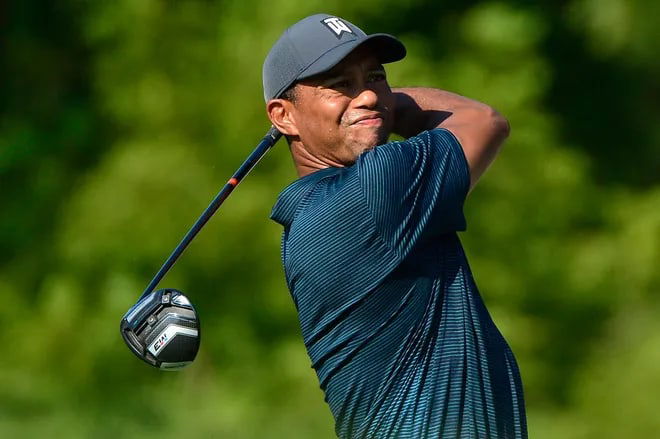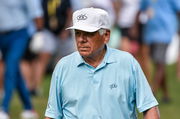
USA Today via Reuters
credit: Jeff Curry-USA TODAY Sports

USA Today via Reuters
credit: Jeff Curry-USA TODAY Sports
He wasn’t just another teenage prodigy chasing a title; he was already a myth in the making. In 1996, before the world saw the red shirt on Sundays, those who stood across from Tiger Woods already knew they were up against something far bigger than raw talent. Those who played against him remember not just the swings, but something else entirely.
Watch What’s Trending Now!
One of those players was Steve Scott — Tiger’s final opponent in the 1996 U.S. Amateur Championship, and the man who nearly stopped him from making history. Their intense 38-hole showdown wasn’t just a test of talent, but a battle of wills, cementing Scott as Tiger’s fiercest amateur rival before Woods turned professional. Recently, Steve Scott appeared on the 5 Clubs Podcast and shared a memory from the Championship, something only someone inside the ropes could’ve known.
When asked what stood out the most about Tiger Woods’ game and character while battling him for the title, he replied, “I would have loved his length off the tee…I would like maybe one more percent of will. Uh, we both had our wills tested that day. But I think the one thing that really sticks out to me would be his ability to compartmentalize.” Scott acknowledged Tiger’s huge advantage in driving distance, saying he outdrove him by more than 50 yards, giving Tiger a clear edge in attacking the course.
ADVERTISEMENT
Adding to the challenge was the immense pressure from the crowd. The 1996 U.S. Amateur final drew an estimated 15,000 spectators lining the first hole early that morning, an unusually large audience for an amateur event. This intense atmosphere tested both players’ mental strength.
Scott pointed to something deeper: that while both players had strong wills tested under pressure, Tiger had just a bit more mental toughness. What truly set Woods apart, Scott explained, was his ability to compartmentalize, meaning he could block out distractions, pressure, and mistakes, focusing entirely on the next shot. This rare mental skill allowed Tiger to stay composed and perform at a consistently high level, even in the most intense moments of the match.
“He really flipped a switch the morning of 18. I mean, I was five up after 18 holes…. And he had a $40 million check from Phil Knight waiting for him when that match was over.” Scott added, that $40 million check from Phil Knight was Tiger’s very first Nike contract, signed in 1996 when he was just 21 years old. If he had lost that match, there was a real chance he could have lost that sponsorship deal too. But instead of feeling nervous, Tiger used the pressure to stay sharp. He blocked out everything else and focused only on his next shot. He shot about a 65 in the second 18 holes to force the match into a playoff, which then extended to an intense 38 holes.
ADVERTISEMENT
View this post on Instagram
Before the second 18 holes, Tiger practiced with his coach Butch Harmon, while Scott and his girlfriend Kristi, now she is his wife went shopping to clear their minds. This shows how differently the players coped with pressure and prepared for what lay ahead.
ADVERTISEMENT
“I think that that compartmentalization ability was his strength,” Scott added according to Scott It was this clear-headedness that helped Tiger stay consistent and in control, even in the toughest moments. At just 20 years old, Tiger Woods had already won five United States Golf Association (USGA) championships, three U.S. Junior Amateurs and two U.S. Amateurs. In 1996, he made history by capturing his third consecutive U.S. Amateur title, completing what’s known as the “triple trifecta.” The final against Steve Scott was a marathon battle that stretched to 38 holes, showcasing Tiger’s incredible skill and mental toughness in one of the most defining moments of his amateur career.
Just a year later, he won his first major, The Masters in 1997. Woods had already become such a huge name in golf that even his longtime caddie, Steve Williams, was hesitant to join him.
Top Stories
Lee Trevino, 86, Leaves Golf World Hanging on Every Word at PNC: ‘I’ve Been Digging Worms’

Paige Spiranac Shares Her Mom’s Honest Views on Controversial Career Decisions

‘Losers’: PGA Tour Pro Blasts Fan Behavior After Viral NFL Arena Incident

LIV Golf Issues Statement as Pro Announces Shock Retirement After Getting Relegated

Korean PGA Tour Star Clears the Air on LIV Golf Rumors With Blunt Message

ADVERTISEMENT
Woods’s Rise Was So Big, Even His Future Caddie Had Doubts
Steve Williams was well aware of the pressure and intensity that came with caddying for one of golf’s biggest stars even before he officially teamed up with Tiger Woods. “I knew the job would be intense, I knew it wasn’t going to be an easy job,” Williams said. The role was about much more than just carrying a golf bag; it meant managing constant media attention, large crowds, and the high expectations placed on Tiger. Williams understood that joining Woods would put him in the spotlight like never before, and that the job would demand a level of dedication and resilience far beyond typical caddying duties.
Despite already having experience working with top-ranked players like Greg Norman, Williams didn’t rush into the decision. “I didn’t tell him right there and then I was going to take the job,” he admitted. Instead, he took a full 24 hours to consider the offer carefully. He talked it over with close friends and thought about the challenges that lay ahead. That reflection period showed just how seriously Williams took the commitment. Ultimately, he accepted the role—a decision that would not only shape his own career but also redefine the professional golf landscape alongside Woods’s rise to greatness.
ADVERTISEMENT
ADVERTISEMENT
ADVERTISEMENT

